
About UsThe Numismatic Bibliomania Society is a non-profit organization promoting numismatic literature. For more information please see our web site at coinbooks.org SubscriptionsThose wishing to become new E-Sylum subscribers (or wishing to Unsubscribe) can go to the following web page link MembershipThere is a membership application available on the web site Membership Application To join, print the application and return it with your check to the address printed on the application. Membership is only $15 to addresses in the U.S., $20 for First Class mail, and $25 elsewhere. For those without web access, write to: David M. Sundman, Secretary/TreasurerNumismatic Bibliomania
Society AsylumFor Asylum mailing address changes and other membership questions, contact David at this email address: dsundman@LittletonCoin.com SubmissionsTo submit items for publication in The E-Sylum, just Reply to this message, or write to the Editor at this address: whomren@coinlibrary.com
BUY THE BOOK BEFORE THE COINYou won't regret it! |
- WAYNE'S WORDS: THE E-SYLUM MARCH 25, 2012
- NEW BOOK: TOP CHINESE COINS - SILVER COINAGE
- READ THE APRIL ISSUE OF THE NUMISMATIST ONLINE FREE
- NUMISMATIC LITERATURE AT THE YALE LIBRARY
- ALAN WEINBERG RECALLS JACK COLLINS
- ONLINE SEMINAR ON ISLAMIC NUMISMATICS
- NOTES FROM E-SYLUM READERS: MARCH 25, 2012
- MORE ON BRENNER AND EAGLE ENGRAVING & STAMPING
- MORE ON MANSHIP'S KULTUR IN BELGIUM MEDAL
- QUERY: 19TH CENTURY U.S. PORTRAIT IDENTIFICATION SOUGHT
- QUERY: SPANGENBERGER 1876 CENTENNIAL COLLECTION SOUGHT
- THE BENTLEY COLLECTION OF BRITISH GOLD SOVEREIGNS
- HARVEY STACK REMEMBERS LAMMOT DUPONT
- SOME SELECTED STACK'S-BOWERS MARCH-APRIL 2012 AUCTION LOTS
- THE NUMISMATOURIST REPORTS FROM LONDON AND GERMANY
- HOLABIRD-KAGIN AMERICANA WESTERN STATES TOKEN AUCTION MARCH 2012
- 10 REASONS WE NO LONGER NEED THE PENNY
- FEATURED WEB PAGE: THE FIRST FOOT GUARDS
WAYNE'S WORDS: THE E-SYLUM MARCH 25, 2012

We have no new subscribers this week. We have 1,524 email subscribers, plus 173 followers on Facebook.
This week we open with a review by John and Nancy Wilson of a new book on Chinese coinage. Other topics include the latest issue of The Numismatist, Islamic numismatics, collector Lammot DuPont, and Howard Berlin's travelogue from London and Germany.
To learn more about Yale's numismatic book collection, the medals of expressionist artists Karl Goetz, Walther Eherbac and others, the Bentley Collection of British gold sovereigns, 45 mule-drawn wagons full of Spanish bullion arriving at the Tower Mint, Alakchick Clam Shell money, and the cost of gin to get dead drunk on, read on. Have a great week, everyone!
Wayne Homren
(whomren@gmail.com)
Numismatic Bibliomania Society
NEW BOOK: TOP CHINESE COINS - SILVER COINAGE
Edited by Michael Hans Chou with Ron Guth and Bruce Smith,
Published by iAssure Group,
Reviewed by John and Nancy Wilson, NLG
 Top Chinese Coins - Silver Coinage by Michael Hans Chou, Ron Guth and Bruce Smith is a 170 page hard cover, coffee size table reference, that it fully illustrated and in full color. All the top 60 coins in this reference have been enlarged to about four inches (in full color). This allows the viewing of even the smallest details. The 60 coins will be found in 60 short chapters. This reference is an update of an earlier book with the same name which was released in June, 2010. The 1,000 copies produced quickly sold out.
Top Chinese Coins - Silver Coinage by Michael Hans Chou, Ron Guth and Bruce Smith is a 170 page hard cover, coffee size table reference, that it fully illustrated and in full color. All the top 60 coins in this reference have been enlarged to about four inches (in full color). This allows the viewing of even the smallest details. The 60 coins will be found in 60 short chapters. This reference is an update of an earlier book with the same name which was released in June, 2010. The 1,000 copies produced quickly sold out.
The reference is written in Chinese and English and covers the period 1850 through 1949. Descriptions of the pieces with large full color pictures along with auction results, price trends, private selling prices and their "Kann" historical values. Their rarity is shown from 1 (extremely common) to 10 (very rare). One * (star) for extremely rare and ** (stars) for the highest rarity.
The market for Chinese coins is on "fire". With the high value of the Yuan and prosperity in China, the people of China can now afford coin rarities from their country. According to co-author Ron Guth he credits Michael Chou and Champion Auctions with the steady rise in Chinese coin prices, especially the rarities.
Starting in October 2009, five seminars were held in Beijing, Hong Kong, Shanghai, Singapore and the United States having 150 participants. Surveys were sent to 138 numismatic experts and collectors and 102 were returned (45% from mainland China). The experts using: rarity, value, quality, popularity, beauty and historical significance decided the coins which you find in this book.
We found it interesting to see the steep increase in prices from the 1954 Kann catalogue to the present time. Finally the rarity and condition is reflected in the present prices. At the end of the book the great Asian numismatists are listed with a biography of each and their contribution to Chinese numismatics.
Selling for $100 the Top Chines Coins - Silver Coinage is expensive. The information contained within the reference though is priceless. After reading and reviewing this book we think the selling price is a bargain. We don't think the authors and publishers will even get back their original investment in the book. It is a high quality, well researched and written reference that will quickly sell out like the first edition did. It would be a great addition to not only collectors of Chinese coins but also dealers, collectors, investors, researchers, bibliophiles, museums, libraries and anyone else who has an interest in well done numismatic references. For information on purchasing this book you can contact Michael Chou at Email: championghka@gmail.com
READ THE APRIL ISSUE OF THE NUMISMATIST ONLINE FREE
Read the April issue of The Numismatist online for FREE! This offer is for a limited time only.
-
 Medals commemorating the War of 1812 (p. 34)
Medals commemorating the War of 1812 (p. 34)
- The legalities of owning 1933 double eagles (p. 42)
- A Magnentian hoard discovered in England (p. 49)
- The 1936 Columbia sesquicentennial half dollar (p. 56)
- Alexandria solidi of Justinian I (p. 65)
Contributors include:
- Jim Wells
- Q. David Bowers
- Anthony Wilson
- Carl Stang
- Harlan Berk
- John J. Kraljevich Jr.
- Jake Sherlock
- Wendell Wolka
. . . and, of course, your favorite monthly columnists:
Q. David Bowers * Rod Gillis * Jerry Cestkowski * David Lange * Nancy Oliver & Richard Kelly * Mitch Sanders * Chris Shappell
This issue offers these great online features:
- Interactive editorial and advertising content, with quick links to all printed e-mail and web addresses
- Expanded pull-down menus, with ready access to editorial content and advertisers
- High-resolution printouts and downloadable PDFs
- Fully searchable text and advertising
- Text-only viewing option with instant translations in 38 languages. (Click on titles and subheads highlighted in red to access this option.)
- Digital magazine archives (January 2009 - present)
- Digital convention program archives (January 2009 - present)
To read the complete issue, see: admin.listpilot.net/mpower/showHtml.do?ac=money&id=718lbte_2b188e87
NUMISMATIC LITERATURE AT THE YALE LIBRARY
Paul Schultz writes:
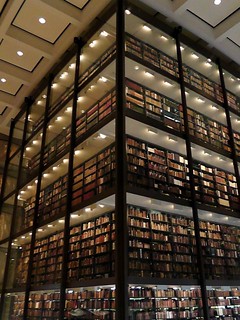 I read the E-Sylum item on the Beinecke Rare Book Library at Yale, but it did not mention their rare numismatic book collection. About 25 years ago, my wife worked at Yale, and at that time it was much more difficult to get in to their collection, but I was able to have access because of her.
I read the E-Sylum item on the Beinecke Rare Book Library at Yale, but it did not mention their rare numismatic book collection. About 25 years ago, my wife worked at Yale, and at that time it was much more difficult to get in to their collection, but I was able to have access because of her.
The Beinecke (the old building, when I was there), had an entire room full of nothing but rare numismatic books. I seem to recall perhaps 4 to 6 rows of shelves in a room reached by narrow passageways, the room was about 10 feet by 20 feet, in a building that seemed rather Gothic. I was primarily a US collector at the time, just beginning ancients and medieval coins, and marveled that so many of the coin books were older than most of the coins in my collection. You should mention that assuming the numismatic collection is now so easily accessible, it is fascinating both for the early books and for owners of obscure coins who need rare books to identify them. The biggest problem was that many of the books are in foreign languages.
To read the earlier E-Sylum article, see: BOOKS AS ART: THE BEINECKE RARE BOOK LIBRARY (www.coinbooks.org/esylum_v15n12a24.html)
THE BOOK BAZARRE
ALAN WEINBERG RECALLS JACK COLLINS
 I learned early on that "Jack Collins" was not his real name and that he had had a career in another field. Does anyone know what Collins' background and real name were?
I learned early on that "Jack Collins" was not his real name and that he had had a career in another field. Does anyone know what Collins' background and real name were?
My last remembrance of Jack Collins was not a pleasant one. A silver choice Proof 76 mm James K. Polk Indian Peace medal was coming up in a remote and obscure antique dealer's private auction in Northern San Diego County perhaps 20 years ago... I seem to recall La Jolla. The dealer was handling part of the descendants' share of President Millard Fillmore's estate and this medal belonged to President Fillmore. The Polk Indian Peace medals in silver are among the rarest of silver peace medals.
The sale received some publicity a few days before the auction in the Los Angeles Times as the auction sellers were two middle-aged ladies. I was aware of the sale and had arranged by phone to drive down to their home on closing night to get in the final bid after talking with them by phone and finding out what numismatic and political items were in the sale.
In the meanwhile, Jack Collins called me up and during the conversation (he was doubtless "fishing" ), asked me if I was aware of the sale not too distant from my home as he was executing a commission bid for John J. Ford, Jr. and would be earning some money. Of course, I denied knowing about the sale as Ford and Collins could then "adjust" their bidding levels knowing another knowledgeable serious bidder was aware of the sale. Ford and I often competed as we had similar tastes and Ford always considered himself to be "entitled".
The night of the auction closing it took me 2 1/2 hours to get down to the ladies' home due to the heaviest downpour I've ever driven in - to this day. I first examined the medal at their house that evening and it was indeed a prooflike silver 76 mm original. The phoned-in bids came in until 8 PM closing time at the ladies' home as I sat at their kitchen table and the bid levels reached $8,000. The ladies told me that Rex Stark was high bidder at $8,000 - not Collins.
As per my prior agreement with the ladies, I bid $100 more and won the medal and drove home again in the downpour which had not ceased. But I had the medal in my pocket and I remember thinking at that time about George Walton's fatal driving experience with his rare coins scattered on the highway - it was that scary driving late at night in that storm.
Several weeks later, I exhibited the medal in Paul Koppenhaver's case at the Long Beach coin show, being very proud of my new prize. Jack Collins happened to be there and approached me asking if I was the new owner. I said yes at which time Jack literally went into a jumping and screaming tirade, at the top of his voice. But I just bit my tongue and walked away. Half an aisle away, Collins was still screaming at the top of his lungs every word in the "street dictionary".
Jack died a short time later, I believe of a heart attack. I still have the medal.
To read the earlier E-Sylum article, see: THE NUMISMATIC BOOKIE HIGHLIGHTS THE ASYLUM (www.coinbooks.org/esylum_v15n12a02.html)
ONLINE SEMINAR ON ISLAMIC NUMISMATICS
Beginning on April 13, 2012 Professor Stefan Heidemann of Hamburg University will offer a seminar on Islamic Numismatics as a Source for Economic, Political and Art History of the Middle East. The web class will cover various topics of Islamic numismatics.
Islamic coins are the most prolific epigraphic sources for pre 1500 history in the Middle East. Nevertheless their potential for understanding urban or regional history is often neglected, even in comparison to other material sources, such as ceramics and pottery, which usually get much more attention. This course is designed to introduce historians and archaeologists to the main issues of working with Islamic coins and coins finds.

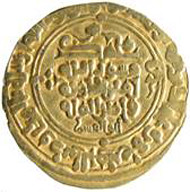
Why are Islamic coins so important for history? For the period prior to the fifteenth century, historians of Islamic societies have almost no primary documents or archives at hand. In contrast to scarce primary documents, the secondary sources - literary and historical accounts especially from the ninth to the tenth century - are abundant. This gross imbalance between the primary documents, produced in the course of the events, and chronicles written much later, has led scholars to depend greatly upon medieval but secondary authors. Coins offer the often needed primary independent evidence produced in the course of events.
Islamic coins as bearers of texts - there can be up to 150 words on one coin - are unique in the history of civilization. They are in fact a condensed form of text document which needs to be deciphered in various ways, serving different fields such as political, economic, industrial, social and legal, Islamic art and material culture, and metallurgy. As groups coins constitute a source of their own - such a sequence of coins from a single mint as historical narrative, as hoards and as archaeological coin finds form a single location they serve as a source for an economic and urban history.
The class will explore topics such as
- definition and terminology of coins and coinage
- production and organization of a mint
- coins as means of economic exchange
- coins in a legal context
- history of coinage and economy in the Middle East
- reading and analysing of coins from different periods
- archaeological coin finds and their interpretation
- coin hoards and their interpretation
The web class explores these dimensions of the coins and coinages. The class will be held in English, via the internet. Registration in advance with the lecturer is mandatory for the preparation and setup of the equipment.
To read the complete article, see: Islamic Numismatics online seminar at Hamburg University (www.coinsweekly.com/en/News/4?&id=1097)
NOTES FROM E-SYLUM READERS: MARCH 25, 2012
Russ Logan Library Goes Missing
Myron Xenos writes:
Brenda Logan (Russ's widow) was over to my office this week to do her taxes, and I asked her, as I always do, if she was ready to sell Russ's library. In the past, she has always said she needed to inventory it first. She had his library shrink-wrapped and palletted and in her son's storage facility.
Apparently he decided that it had no value and proceeded to dump it. I have no proof beside Brenda's word, but she seemed disturbed and I believe it, as she said she didn't even want to talk about it. I had hoped to list the books for bids, but that won't happen. For researchers, this loss is akin to Caesar "accidently" torching the Library in Alexandria.
These things happen occasionally. When we were doing numismatic literature auctions, we received several boxes of books from Patrick Breen, which we sold through our mail bid sale. Patrick was supposed to send us the remainder of Walter's library (which may have included some non-numismatic non-fiction better-left-unread stuff) but the years have never revealed where it ended up.
Books can be replaced, but research unshared is lost forever. My sympathies to all of us.
The Roman Imperial Coinage, Volume II - Part 2
C. Gregory McMurdo writes:
Does anyone have any idea when The Roman Imperial Coinage, Volume II - Part 2 will be released? RIC Volume II - Part 1 was published by Spink in 2007. It was my understanding at the time that Part II would follow within a year. Any information readers could provide me regarding the status of RIC Volume II - Part 2 would be greatly appreciated. I collect coins of Hadrian and am most anxious to catalogue that those coins using the new volume. I am a member of the Numismatic Bibliomania Society and greatly look forward to receiving both The Asylum and the E-Sylum.
Sweden - A Cashless Economy?
Including a link to another article about the proposal about eliminating cash in Sweden, David Klinger writes:
Ironically, I think this would enhance numismatics. We know what happens to the works of dead artists.
To read the complete article, see:
Sweden Moving Towards Cashless Economy
(www2.wkrg.com/news/2012/mar/20/sweden-moving-towards
-cashless-economy-ar-3443994/)
To read the earlier E-Sylum article, see: SOME SWEDES ADVOCATE ELIMINATING CASH (www.coinbooks.org/esylum_v15n12a21.html)
MORE ON BRENNER AND EAGLE ENGRAVING & STAMPING
Regarding the Brenner medal mentioned last week, David Schenkman writes:This medal is well known to collectors. It is listed in Benjamin P. Wright's American Business Tokens as number 277, which dates it the late 1880s or 1890s.

Dick Johnson writes:
There were two Eagle Engraving companies, one in Philadelphia (post 1905) and one in New York City, although its full name was Eagle Engraving and Stamping Company, as indicated by the full lettering on the obverse legend of the piece illustrated. The latter flourished in 1895, the approximate year in which Victor D. Brenner engraved this piece.
But the big story is not the piece itself, nor the fact it was engraved by Brenner -- although that is a big fact in itself -- and Brenner had engraved 17 undated medals and 29 dated medals that we know of in this period of his career (1892-1896).
Brenner had immigrated to America (from Lithuania), arriving May 10, 1890. He was 19 years old, and had engraved his first American medal (dated 1892). He was hired by Robert Stoll Engraving Company in 1894 and later that same year -- November 19, 1894 -- Professor Sigmund Oettinger of City College took Brenner to visit the American Numismatic Society and introduced him to their collections of coins and medals. It opened Brenner's eyes to a new world of medals.
But the big story about this piece is not about Brenner -- it is about the status of engraving companies in New York City at the time. The first World's Fair -- in Chicago 1892-93 -- had attracted European die engravers to America for the work opportunities the World's Fair offered. Indeed over a thousand medals and diestruck items were issued for this event alone. But the years following did not sustain the engraving industry, in other major cities as well as Chicago.
New York City saw the merger, undoubtedly brought on by the decline of business occurring because of the post World's Fair slump, of many engraving companies and one-man operations. I suspect this was the case of this New York City Eagle Engraving Company, a merger of two firms as evidenced by the two addresses on the reverse. Unfortunately we do not know the identity of the principal who joined with Robert Stoll -- or why two addresses are given.
This one medal, however, is the only item that can be documented as issued using the Eagle Engraving name. The Robert Stoll company continued (until at least 1929), but apparently used the Eagle Engraving name only this one time.
It mirrors a similar situation in the merger of three firms (and individuals) with the new name New York Engraving and Die Sinking Company. The instigator was engraver Fred Koch (active 1887-93), who became the president of the new firm. He had been a one-time partner of Gustav Horst, but Horst dropped out, so Koch brought in Horst's old partner, Frederick B. Smith (who had been with Smith and Seward (Seward was not an engraver). Koch also joined with engraver H.R. Wartenberg, to become VP of the new firm.
A letter, dated 28 April 1893, in the files of the ANS and recorded in the Richard Kenney archives, explains this musical chairs among the city's engraving companies' personnel. Unfortunately, we do not have such clarifying documents from Robert Stoll on the Eagle Engraving Company. It would have been extremely useful had such existed..
We do know that is a splendid medal Brenner engraved for Robert Stoll early in his employment, probably only a year after he was hired.
To read the earlier E-Sylum article, see: QUERY: EAGLE ENGRAVING & STAMPING INFORMATION SOUGHT (www.coinbooks.org/esylum_v15n12a10.html)
MORE ON MANSHIP'S KULTUR IN BELGIUM MEDAL
Bob Mueller writes:
It seems that I completely missed this one in the last issue and for the interest of fellow readers I felt I needed to weigh in. Here is an excerpt from my manuscript on Manship's medals...
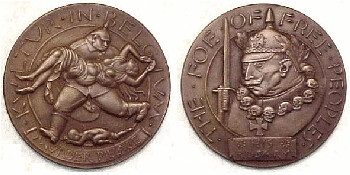
The outbreak of the First World War in Europe heralded a period, as in any war, of intense national pride and artistic creativity. From the designing of monuments and decorations honoring the heroic to patriotic posters, art was created to stir the hearts and minds of the populace to a national unity of consciousness. Whether to build hope and pride or to instill outrage against the enemy, many artists focused their talents to the production of propagandistic works. The popularity of the poster, which had grown immeasurably during the latter half of the nineteenth century, made it the ideal medium for spreading the national ideology. The medal though, became a more enduring means of communication. Their durability and portability made them ideal for disseminating propagandistic messages and they became the perfect forum for sculptors to express their own feelings about the war.
No country made better use of this medium than Germany and in their attempt to disassociate themselves from the florid classicism that seemed to permeate the rest of Europe, developed an Ayrian style of heroic realism. Although they cannot be considered as good art, the medals produced sold very well and raised a great deal to swell the German war chests. As the war wore on the technique and style became almost as brutal as the subjects portrayed. Expressionist artists like Karl Goetz, Walther Eherbach, Zadikow and May produced hundreds of medals and some of the most horrific images ever seen in their 'Dance of Death'.
In France, though now the center of the Avant Garde movement and its radical new approach, the field of medallic art seemed to be locked into increasingly sterile variations of Art Nouveau. The attempts to adapt this decorative style to a brutal war failed miserably and the French medals of this period seem stiff and overly sentimental.
America for the most part, exhibited a wait and see attitude as far as art was concerned. And although she didn't enter the war until late in the conflict the American people opened their hearts and wallets to help the war ravaged countries of Belgium, France and Italy. Some funds were raised through the sale of commemorative medals such as the 'Jeanne D'Arc' for the Italian War Relief, but for the most part American medallists remained uncommitted in their art. Manship's next effort was considered at the time the first true American war medal and raised quite a lot of money, but also stirred almost as much of an uproar as the Metropolitan Magazine incident.
The Kultur Medal, was the sculptor's personal statement of outrage against the Kaiser's bloody campaign in Belgium. Advertised as the 'First American War Medal' it would be welcomed by "Patriotic Americans who have deplored the fact that our artists, sculptors and medalists have apparently derived so little artistic impulse from the war." The piece was created to raise funds for the War Relief and sold for the 'hardly popular price' of ten dollars apiece. It must have touched a popular chord though, because the medals sold briskly.
However, much to Manship's confusion, the critics hated it. One stated that "it engenders hatred and places us on the same level with the 'powers that be' in Germany... Evil does not excuse evil and in fighting this battle for ideals we must prove that our ideals lead along a more excellent way." Another wrote in the American Magazine of Art that the Kultur 'puts into permanent form those things which if possible should not be remembered, but if remembered not visualized... one cannot rejoice in art which visualizes these bestial crimes and by spending one's art on such a subject the artist desecrates the great gift with which he was devinely endowed." Even Alice Longfellow, daughter of the poet Henry Wadsworth Longfellow, wrote a scathing letter to Manship, 'I wish to make a strong protest against anything so hideous being issued in the name of Art or of America. Nothing worse could have been made by the Germans. Whereas the French and Italians have made very beautiful medals. I trust American artists will not endorse it"
Even with these negative reactions, there were still a few voices raised in favor of the medal. "It is a fine thing for American Art that Paul Manship, one of our most brilliant and conspicuous sculptors, should have taken up this much needed task in America... this wonderful bit of sculptured Hate is meeting with a large and popular sale." From another source, "It is altogether likely that the German Emperor will put a price upon the head of Paul Manship when he sees the medal which this sculptor has lately finished."
Looking at the Kultur Medal the artists outrage is revealed through his brutal portrait of Kaiser Wilhelm II with a rosary necklace of skulls for his Iron Cross while on his helmet he dons the laurel crown of a would-be Ceaser. His beady eyes seem to stare, as cold as the steel of the bayonet before him as if checking the sharpness of its edge. The legend seems to be split to the two opposing sides of the medal, "THE FOE", on the left side and "FREE PEOPLES" on the right, the word "OF" being separated and sandwiched between the bayonet and the spike atop the fiends helmet.
The reverse shows a brutish, almost Neanderthal like, German soldier abducting a young woman while her baby lays dead on the ground. Looking closely at the face of the soldier we see his gaze on the woman's breasts and the small sadistic smile as he thinks about the brutal rape he is about to commit. The image of brutal killer is enforced by the legend "KULTUR*IN*BELGIUM*MURDER*PILLAGE" and the piece is signed above the dead child.
To read the earlier E-Sylum article, see: QUIZ ANSWER: MANSHIP'S KULTUR IN BELGIUM MEDAL (www.coinbooks.org/esylum_v15n12a15.html)
THE BOOK BAZARRE
QUERY: 19TH CENTURY U.S. PORTRAIT IDENTIFICATION SOUGHT
From London Christopher Eimer writes:
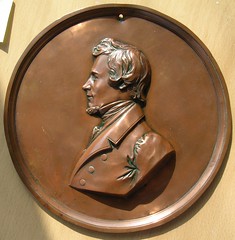 I continue to enjoy the weekly submissions of The E-Sylum and its wide and varied subject-matter. On the subject of identifying portraits, I wonder whether someone amongst your knowledgeable readership might be able to identify a portrait - which I believe to be of a U.S. citizen - that appears on a well-made, high-relief bronzed electrotype, measuring 240 mm. in diameter and dating, I would imagine, from somewhere around the mid-nineteenth century.
I continue to enjoy the weekly submissions of The E-Sylum and its wide and varied subject-matter. On the subject of identifying portraits, I wonder whether someone amongst your knowledgeable readership might be able to identify a portrait - which I believe to be of a U.S. citizen - that appears on a well-made, high-relief bronzed electrotype, measuring 240 mm. in diameter and dating, I would imagine, from somewhere around the mid-nineteenth century.
QUERY: SPANGENBERGER 1876 CENTENNIAL COLLECTION SOUGHT
1876 Centennial Medals and Tokens Collector Ron Abler writes:
I didn't know Hank Spangenberger except from his very informative articles entitled "Wooden Medals Unique mementoes" in the March 1969 issue of the Numismatic Scrapbook Magazine. Once the article made his name familiar to me for the first time, I began to hear snippets of his superb 1876 Centennial collection that had been sold. Can you promote Dick Johnson's: "Perhaps some E-Sylum reader can remember to whom." to my: 'I really would appreciate it if someone could put me in touch with the current owner of that collection, if it is indeed still intact."?
Donald G. Tritt adds:
"It has been my pleasure to have known Hank over the past 30 years. As is well known, Hank had a collecting interest in many numismatic items out of the ordinary - one of these being wooden medals, plaques and tokens of U.S. Expositions and Fairs. This interest brought us together and he became a mentor and an extra set of eyes for building my collection of Die-Pressed Wooden Exonumia. His ability to note and remember fine detail was phenomenal. He was always interested in seeing a latest discovery.
I honor Hank as a committed and discerning Numismatist, a gentleman in every regard. His funeral in Oakwood, OH (a suburb of Dayton) on March 16 was a loving family occasion. In attendance were his four children, relatives, friends and his long time friend and companion Phyllis Thompson - all honoring his memory and his special contribution to their lives. A significant numismatist, mentor and friend has left our collecting fraternity."
To read the earlier E-Sylum article, see: MORE ON HANK SPANGENBERGER (www.coinbooks.org/esylum_v15n12a19.html)
THE BENTLEY COLLECTION OF BRITISH GOLD SOVEREIGNS
What began as a foray into the numismatic world as a way of owning gold in the late 1970s quickly became a passionate quest to formulate one of the greatest collections assembled of the British Gold Sovereign. Not only was the collector fascinated by the Sovereigns standpoint in history, as one of the most long-lived, respected and widely distributed coins in the World but, they were also awestruck by the physical form the Sovereign takes, being 22mm in diameter, weighing 7.98g and struck in 22 carat gold. From the start there was a strong focus on acquiring only the highest quality pieces for the collection and a decision to focus on modern currency Sovereign (1817 onwards.)
The sale of the first part of this outstanding collection will be held on the 8th May in London and contains over 380 individual lots, all from the Royal Mint when it was based in London. Apart from the extremely rare 1819 Gold Sovereign, part one of the Bentley Collection contains at least one example of every single date issued for currency in the UK, as well as many Pattern and Proof (prototypes of coins) issues. The extremely rare 1819 Sovereign, the finest known specimen in private hands, will be offered for sale in part three of the collection, due to be sold in May 2013.

An 1817 George III (1760-1820), Proof Gold Sovereign, 1817, engraved by Benedetto Pistrucci depicts the laureate head of the King and a reverse showing the first incarnation of the now iconic image of St George slaying the dragon with a broken lance. The resulting Sovereign design adopted for currency, here demonstrated struck to 'Proof' quality from highly polished dies. Such delightful pieces were gifts given to highly influential persons to show the pride in the new design; today they are extremely rare.
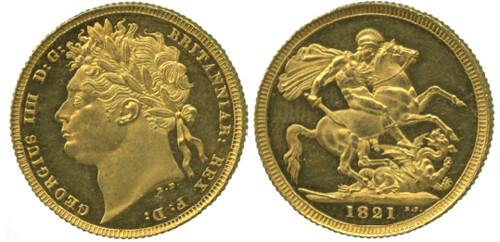
An 1821 George IV (1820-30), Proof Gold Sovereign, 1821, also engraved by Benedetto Pistrucci, depicts St George slaying the dragon right with sword, no helmet streamer, horse's tail with three terminal strands, broken lance on ground to left. The second incarnation of the St George and dragon reverse design has proven to stand the test of time, and become the most iconic and long-lived depiction of any coin design in the World with little change over the 190 years of issue till 2011.
For more information, see: www.baldwin.co.uk/bentley/
HARVEY STACK REMEMBERS LAMMOT DUPONT
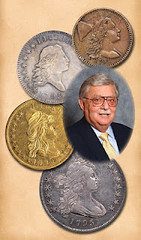 In the late 1940s and early 1950s many famous collectors came through the doors at Stack's busy 12 West 46th Street headquarters. Even before I began working full-time in 1947, I had the good fortune to meet and serve many of these well-known collectors. I recognized all of them as numismatic leaders. The passage of time has revealed just how great many of them were in the broad history of American numismatics.
In the late 1940s and early 1950s many famous collectors came through the doors at Stack's busy 12 West 46th Street headquarters. Even before I began working full-time in 1947, I had the good fortune to meet and serve many of these well-known collectors. I recognized all of them as numismatic leaders. The passage of time has revealed just how great many of them were in the broad history of American numismatics.
I met Lammot Dupont in the latter part of the eventful 1940s. I was working at a cataloging desk midway down the length of our retail counter. Part of my job was to keep an eye on who came and went through the front door.
One day a gentleman came in and sat down at the counter. My Uncle Joe and father, Morton, both responded to the counter to serve the visitor. It was a bit puzzling to see both senior Stacks going to greet this particular visitor. He was dressed in a heavy winter coat, somewhat out of style for the period and actually a bit threadbare. He also wore a large brimmed felt hat, somewhat crushed, with a band that was a little stained.
As my father spoke with our visitor, Joe came to my desk and said, 'Where is that 1795 silver dollar that I bought yesterday?" I had it on my desk as I was enveloping it for stock. My uncle ran back to the visitor and then came back to me for some other new additions we had acquired for stock.
On one of Uncle Joe's many trips to my desk and inventory stock boxes, I asked, 'Who's that, that BOTH of you are so attentive to?" He responded, 'That's Lammot Dupont!" I quickly reached into the file and took out a 1795 silver dollar in Mint State. I asked 'Why did you show him the 1795 specimen in About Uncirculated rather than this lovely Mint State?" The first was in stock at $60 while the Mint State coin was then about $100. My Uncle Joe immediately responded 'He doesn't buy early U.S. coins in Mint State." I was naturally intrigued and decided to check into this puzzling matter.
After Mr. Dupont left I asked, 'I'm sure that the money was not a concern to him, so why didn't he buy the Mint State example?" I then learned a key lesson: to give the customer what HE likes, not what I saw as a good buy and a worthy addition to an important collection.
At that time Mr. Dupont gravitated to lightly circulated coins. It wasn't the price but rather the story the coin might tell. If a 1795 silver dollar was not quite Uncirculated, it was quite certain that the coin was actually used in the late 1790s. Mr. Dupont loved to take a coin, hold it by the edge, roll it between his fingers, and wonder who in the 1790s had held and used this same coin. He would imagine that it could have been in the possession of a famous American, such as Thomas Jefferson, Alexander Hamilton, a member of the Adams family, or even George Washington.
He thought all this could make him a part of that long-vanished era, and therefore such lightly circulated coins had vastly more meaning to Mr. Dupont. Yes, we have had many such people who were prominent collectors who wanted coins that might have a story. To Mr. Dupont, the story was as important as the coin itself. It was fun for me to watch him as his deepest thoughts took him back in time.
To read the complete article, see: Remember When: Lammot Dupont (stacksbowers.com/Blogs/remember-when-lammot-dupont.html)

SOME SELECTED STACK'S-BOWERS MARCH-APRIL 2012 AUCTION LOTS
From the March 2012 Baltimore auctions:
Lot 1023: 1745 Spanish Fleet Captured Medal


A far too little known medal, vividly capturing the story of the capture of Spanish silver that inspired the 1745 and 1746 LIMA coinage. The obverse deftly displays the July 10, 1745 capture of the Lewis Erasmus, Notre Dame, and Marquis d'Entin by the English-flagged privateers Duke and Prince Frederick. Portraits of the captains of those two vessels, James Talbot and John Morecock, are displayed being held by Fames on the reverse, while a dramatic scene plays out near the exergue: the last of 45 mule-drawn wagons full of Spanish bullion arriving at the Tower Mint on October 1 and 2, 1745.
To view the complete lot listing, see: stacksbowers.com/Auctions/AuctionLot.aspx?LotID=324082
Lot 4005: 1776 New Hampshire Copper
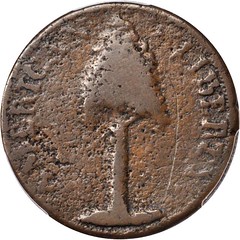

The history of this rare copper New Hampshire coinage is fairly well documented in the literature, especially in Sylvester S. Crosby's Early Coins of America (1875), which reproduces the enabling legislation in the New Hampshire House of Representatives, March 13, 1775, and includes other valuable information relating to the origin of the first of the state copper coins.
The issue was intended "for the benefit of small change," as Continental currency bills were "so large." It was recommended that 108 of the coppers be equal in value from one Spanish milled dollar -- thus setting the weight as about twice that of a British halfpenny and perhaps characterizing the New Hampshire copper as a penny (although no denomination was specified). Walter Moulton was empowered to coin as many as might amount to 100 pounds in weight, subject when made to the inspection and direction of the General Assembly before pieces were made for general circulation.
To view the complete lot listing, see: stacksbowers.com/Auctions/AuctionLot.aspx?LotID=323268
Lot 4178: 1852 Pattern Gold Dollar. Judd-141
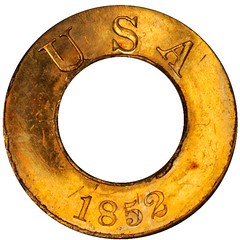
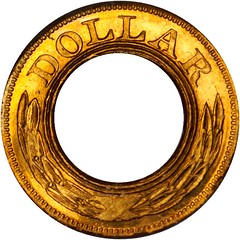
The obverse is of a simple design meant to test the concept, not to create an artistic coin for regular issue. At the top is U.S.A. and at the bottom border is 1852. The coin has a fin or thin wire edge at the perimeter, and another from the central punch, both of which served to protect these devices. The reverse has an open laurel wreath tied at the base with a ribbon, with the leaves all parallel and aligned, with the denomination DOLLAR above. Dentils surround the rim. Large plain perforation at the center.
To view the complete lot listing, see: stacksbowers.com/Auctions/AuctionLot.aspx?LotID=323441
Lot 5227: March 1, 1863. 50 Cents. Choctaw Treasury Warrant.

Uniface. Printed on green rag paper. Medium size format note. 123mm by 52mm. Local typeset in black, with pattern end design, without imprint. At the left end, a pattern border within text in center, all enclosed with solid black frame. Central texts: "The National Treasurer of the CHOCTAW NATION, pay to bearer,/FIFTY CENTS,/In three equal Annual Installments of One, Two and Three years from date/hereof. Dated at Armstrong Academy, in said Nation on this__day of___A.D. 186_" Signature space at the lower right for "National Secretary of said Nation." At the top, "CHOCTAW TREASURY WARRANT" above fancy ornament flanked by spaces for serial numbers (the right, series?). Signed at lower right by 'James Riley'. Signature across upper left of 'S.[amuel] Garland/P.C.C.N.'[Principal Chief Choctaw Nation] and endorsed 'Paid' at the right. Unnumbered. Reissued in 1865 with verso endorsements and reissued notations: 'Reissued per act/Oct 17 1865 with/five percent interest from this date' and signed by 'Allen Wright/Nat'l Treas.'
To view the complete lot listing, see: stacksbowers.com/Auctions/AuctionLot.aspx?LotID=322465
Lot 5957: Postage Stamp Envelopes. Niblo's Garden.
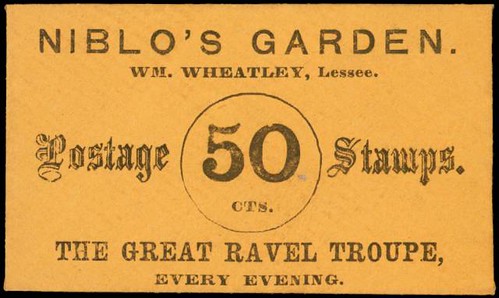
KL 355-50. Orange paper. Black printing on face only. An incredible piece which is one of a reported two known examples for the denomination. A piece which was absent in the Ford holdings and a highlight of the Western Reserve Historical Society Collection. A pair of hinge remnants are seen at on the verso and pleasing embossing is welcomed. A truly stellar item and a highlight of this terrific grouping of envelopes from the Chester L. Krause collection.
To view the complete lot listing, see: stacksbowers.com/Auctions/AuctionLot.aspx?LotID=323195
From the April 2012 Hong Kong auction:
Lot 20385: The Striking Of Yuan Shih-Kai As Hung Hsien Gold And Silver Medals
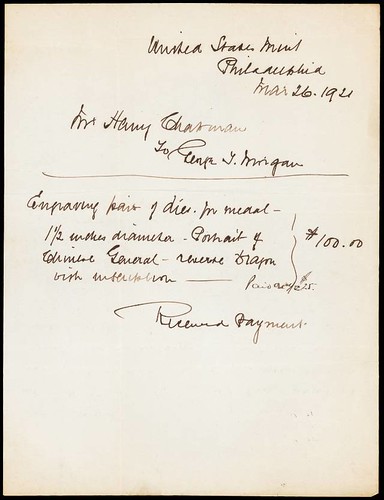
A very interesting group of historical documents that shed some new light to the historical background of the Yuan Shih-kai as Hung Hsien commemorative medals/dollars. It is interesting to note that the receipts for the striking of these are nine months apart. This most likely accounts for why there are different edge varieties on known genuine medals/coins of this type. Although Henry Chapman owned the dies for said issue, it is unlikely he owned the collars to produce the edges. In all likelihood the mint official responsible for striking these would select a collar of the appropriate size each time these were struck. This leaving numismatist today with minor variances in edge designs.
Historically very interesting and unquestionably UNIQUE. A wonderful group of documents that is of great interest for the researcher and are of museum quality and importance.
To view the complete lot listing, see: stacksbowers.com/Auctions/AuctionLot.aspx?LotID=327527
THE NUMISMATOURIST REPORTS FROM LONDON AND GERMANY
It is March and I, the Numismatourist, have my own version of 'March Madness" with my first trip of the year. I first hit London, then Baden-Baden for a little R&R, and then Berlin, afterwards I return to London for an overnight stopover before returning home.
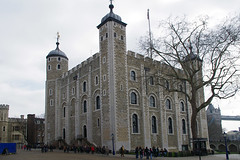 Back at last year's August ANA, the personnel at the British Royal Mint booth told me of an expanded exhibit in the White Tower at the Tower of London, just opposite where the crown jewels are on display. The Royal Mint originally used to be located on Tower Hill (from the mid-13th century to 1810) - it is now located in South Wales. One word of advice. If you plan to visit the Tower of London, buy your tickets ahead of time! The queues at the Tower of London ticket office can be really long. There are several internet sites; I used Viator.com and paid in dollars.
Back at last year's August ANA, the personnel at the British Royal Mint booth told me of an expanded exhibit in the White Tower at the Tower of London, just opposite where the crown jewels are on display. The Royal Mint originally used to be located on Tower Hill (from the mid-13th century to 1810) - it is now located in South Wales. One word of advice. If you plan to visit the Tower of London, buy your tickets ahead of time! The queues at the Tower of London ticket office can be really long. There are several internet sites; I used Viator.com and paid in dollars.
Another word of caution. The White Tower is not handicap friendly. Just to get in, you have to climb about 30 or so wooden steps. The building has no elevators, and getting from the second to third floor (where the money exhibit is) is via a winding staircase. If that wasn't enough, going back down to ground level is all via another narrow winding staircase. I walk with a cane and had to take my time going down. Needless to say, I had quite a line in back of me. I think I heard some grumbling.
 The exhibit is composed of two parts. In one room along with armory items is one case including a reproduction screw press that was used to mint coins from the 1660s until 1810, a nest of troy weights of 1588, a Henry VII sovereign, a Henry VIII crown of the double rose, Edward VI sixpence of 1551. In the other room I suspect the more recent addition of the Royal Mint is gallery of informational displays about the mint and some of its coins, like the William I silver penny, Edward III gold noble, Edward IV gold sovereign, and the George II silver crown.
The exhibit is composed of two parts. In one room along with armory items is one case including a reproduction screw press that was used to mint coins from the 1660s until 1810, a nest of troy weights of 1588, a Henry VII sovereign, a Henry VIII crown of the double rose, Edward VI sixpence of 1551. In the other room I suspect the more recent addition of the Royal Mint is gallery of informational displays about the mint and some of its coins, like the William I silver penny, Edward III gold noble, Edward IV gold sovereign, and the George II silver crown.
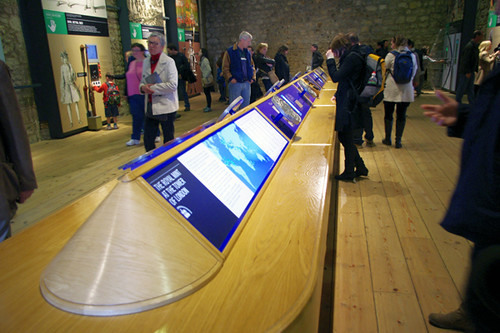
The newer Royal Mint exhibit in the White Tower.
While in Londinium, I also visited the Museum of London Docklands - they have another branch at London Wall. From some info I received there was supposed to be quite a few English coins on display. I even e-mailed one of the people at the museum and got a reply. After I walked through, all I could find were two Roman coins. I was running out of time so a trip to the British Museum would have to wait for my return trip from Berlin.
Germany was more successful. A few years ago I had photographed an exhibit of coins at the famed Pergamon Museum on what is called Museum Island, which included a nice display of coins of the Caesars. However before buying my ticket I inquired about the coins and was told the exhibit was no longer in the museum, but was now in the Altes Museum, also on the island just around the corner. The Altes Museum is a museum of ancient Greek and Roman artifacts but one room is for the permanent numismatic exhibit, which has changed a bit from that of the Pergamon. In 15 display cases, the exhibit covers a selection from the first coins of the 7th century B.C. Lydia up to Roman provincial coinage of the 3rd century A.D.

The German Historical Museum, completed in 1730,
as seen from the Under den Linden.
Another collection visited was the German Historical Museum, or DHM. It is located at the far eastern end of the well-known avenue, Under den Linden, and is almost next to the prestigious Humboldt University. The Baroque-style building is also known in German as the Zeughaus (arsenal), as it was completed in 1730 as an arsenal under Elector Friedrich III of Brandenburg (later King Friedrich I) for the Prussian army. I was lucky today as admission was free, for whatever the reason.
Like many museums, selected items from the museum's numismatic holdings are integrated in with the permanent exhibit that covers the history of Germany (1 BCE - present) rather than its holdings displayed as a separate numismatic exhibit.
The DHM's numismatic collection, which contains approximately 80,000 items, is a result of the merging of the collections of the former East German Museum for German History and the DHM, such that the current collection, contains approximately 7,000 coins, tokens, emergency money, and jetons. The coins range from Roman coins minted in the Rhineland, to the denars, talers, and the German issues of the 19th and 20th centuries. Also included are 5,000 medals and commemorative coins.
The DHM also has an extensive collection of about 60,000 banknotes which represents the period of the Weimar Republic, the German Reich, East Germany (DDR), and the Federal Republic. Other specialized notes include inflation issues and issues by individual German towns, states, private companies, World War I POW camps, and Nazi concentration camps. With such a large collection, it's a shame that not more of it is on display to be seen by the public. One of the more interesting non-numismatic items on display is Napoleon's hat, sword, and spurs, worn at his defeat at Waterloo.
There is one other well-known numismatic collection, probably Germany's best, the Bode Museum which is next to the Pergamon Museum. I've been there several times so there was no need to visit it again.
Upon my return to London before going home, I did have a chance to stop by the British Museum, as I have done so many times in the past. This time was to briefly chat with Dr. Christine Eagleton, the curator overseeing the transformation of the former HSBC Money Gallery in Room 68 on the third floor to the new gallery sponsored by Citi Bank, scheduled to open in June. I'll be in London again in May and hopefully will have an advance peek of the exhibition prior to the grand opening and to update information for my Numismatourist book before it goes to the publisher.
HOLABIRD-KAGIN AMERICANA WESTERN STATES TOKEN AUCTION MARCH 2012
Lot 410: CA - Crescent City/County,1933 - Alakchick Clam Shell

2.5" X 3." Clamshell. Hand painted on underside of shell, 10c / Alakchik / Paid by / Ray Adsit-C.W.Nohl / Crescent City, Calif. / 3/10/33 / H.R. Adsit C. W. Nohl Top of shell is textured and brown with no writing. Both Crescent City and Pismo Beach used these clamshells as circulating currency when the Great Depression hit coastal California communities. Please see the Pismo Beach clamshell for more information. The U.S. Federal Census for Crescent City for 1930 lists Ray Adsit as a garage proprietor and Charles Nohl as an automotive repair clerk. Alakchick must have been the name of their garage.
Nohl was a German immigrant born at sea when his parents came to the U.S. and both Nohl and Adsit, although from different parts of the country, have WWII draft registration cards, which is perhaps where these business partners met. In 2009, Stephanie Simon wrote an article titled Cash-Strapped California's IOUs: Just the Latest Sub for Dollars; In the 1930s, Some Used Shells and Wood As Scrip; the Minneapolis Sauerkraut Note which was published on the Wall Street Journal website (wsj.com). The article mentions the Crescent City Chamber of Commerce clamshells and values them at around $500 each. - Weber Collection
To view the complete lot listing, see:
liveauctions.holabirdamericana.com/CA-Crescent-City-County
-1933-Alakchick-Clam-Shell-Good-For-10c_i12070266
Lot 495: CA - Pismo Beach, San Luis Obispo County - 1933 - California Market Clam Shell
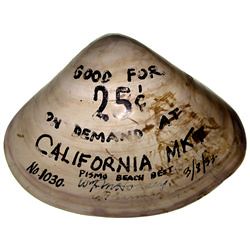
"When the Depression and resulting banking crisis hit their community, the residents of the coastal town of Pismo Beach, California picked an unusual but logical medium of exchange. The pismo is a species of clam with a very thick shell, then found in large numbers along the California coast and prized as a food. A town named after the bivalves suggests an adequate supply of their shells. Perhaps with tongue in cheek, the merchants and officials of Pismo Beach (who were often the same people) decided to make the best of a bad situation, and to make the humble clam shell into an object of trade. This they did. The Chamber of Commerce and no fewer than eleven merchants issued clamshell scrip. Each piece was numbered, and each piece was signed on the front and on the back. As with the stamp notes of the Midwest, it was necessary to sign each clamshell on the back in order to keep it in circulation. No formal requirements may have existed, but informal pressure certainly would have endorsed the practice.…. (The Clam shells were) intended partly as a real, if unique, circulating medium.…. Each piece was numbered, and each was signed on the front and on the back. This specimens are dated 1933. This was in the middle of Roosevelt's national banking holiday, and it is exactly the time when we might expect to see people take money into their own hands."
To view the complete lot listing, see:
liveauctions.holabirdamericana.com/CA-Pismo-Beach-San-Luis
-Obispo-County-1933-California-Market-Clam-Shell-Good-For-25c-1030_i12070350
Lot 584: CA - Stockton,Bohemian Club Good For Mirror
 A.Chiorini, Proprietor. Extremely Rare! Defined as an artist or writer who lives and acts free of regard for conventional rules and practices, since the 1850s the term "Bohemian" has been associated with journalists, reporters and newspapermen. California journalist Bret Harte first wrote as "The Bohemian" in The Golden Era in 1861. Mark Twain called himself and poet Charles Warren Stoddard bohemians in 1867. The original Bohemian Club was a men's club formed in San Francisco in 1872 for journalists, artists and musicians, and then eventually businessmen were also accepted into the fraternity.
A.Chiorini, Proprietor. Extremely Rare! Defined as an artist or writer who lives and acts free of regard for conventional rules and practices, since the 1850s the term "Bohemian" has been associated with journalists, reporters and newspapermen. California journalist Bret Harte first wrote as "The Bohemian" in The Golden Era in 1861. Mark Twain called himself and poet Charles Warren Stoddard bohemians in 1867. The original Bohemian Club was a men's club formed in San Francisco in 1872 for journalists, artists and musicians, and then eventually businessmen were also accepted into the fraternity.
To view the complete lot listing, see:
liveauctions.holabirdamericana.com/CA-Stockton-Bohemian
-Club-Good-For-Mirror_i12070439
Lot 1001: OR - Fort Dalles, c1860 - Fort Dalles Post Bakery
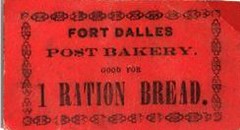 5.5mm x 3mm. Oregon Territory unlisted token "GF 1 Ration Bread." Black on red with border. Signature on reverse. - Vinegar Collection
5.5mm x 3mm. Oregon Territory unlisted token "GF 1 Ration Bread." Black on red with border. Signature on reverse. - Vinegar Collection
To view the complete lot listing, see:
liveauctions.holabirdamericana.com/OR-Fort-Dalles-c1860
-Fort-Dalles-Post-Bakery-Paper-Token_i12070857
10 REASONS WE NO LONGER NEED THE PENNY
This week I just encountered the best article I have read in the decade I have been studying future coins. Of highest priority is the elimination of the cent in circulation. By not changing the composition, not striking cents in steel (or plastic, or cardboard, or whatever). Don't strike cents at all. Abolish the cent.
Writer Dana O. Crandell came up with 10 reasons why. I will paraphrase these:
 1. Low purchasing power, you can't buy anything with a cent.
1. Low purchasing power, you can't buy anything with a cent.
2. Costing taxpayers more than face value to mint cents.
3. Plastic replacing coins and paper money.
4. Cents dropping out of circulation.
5. More realistic pricing by rounding off.
6. Cents worth more as bullion (or collectors' items).
7. Conserve natural resources.
8. Half Cent good example, no body misses.
9. Other country's success in abolishing lowest value coin.
10. Step towards "cashless" commerce.
I responded with a lengthy reply, I liked the article so well. Here it is:
As a numismatic researcher-writer I have, for more than a decade, studied the usefulness of future coins. Denominations have changed over the years and centuries since mankind has enjoyed the utility of coins - since 640 B.C. Denominations have been created, when needed, and abolished when not.
Today we face the elimination of the cent, for the ten reasons mentioned in this article. I have saved articles on this subject, mostly editorials by writers who felt strongly enough to comment in print. The mood has reversed dramatically in that decade from about sixty percent to retain the cent, to currently more than eighty-five percent to abolish.
This change of opinion has been influenced by the rising cost of manufacturing cents - now costing 2.4 cents for each one cent coin minted - plus the fact that the purchasing power of one cent has diminished so low that most people consider pennies a nuisance.
Dana O. Crandell's article is the best I have observed in my decade of studying the subject. The ten reasons mentioned should be carved in stone and sent to every legislator who must make a Congressional decision. They need to make these ten reasons their commandments.
As society advances, prices rise gradually. A loaf of bread is no longer a dime, and a workman receives more than a dollar a day for his labors, prices evident in America's past. Also in that past we had a half-cent coin. It was abolished when its purchasing power was next to nil in 1857 (and the cost of its copper increased). Today, 150 years later, the American cent is in that same situation.
A useless coin, but what to do with over 400 billion cents in circulation? Chicago Federal Reserve Bank chief economist Francois Velde offered the best solution - call them nickels by revaluing them to five cents (he called that 'rebasing") - and let them stay in circulation.
Since the nickel coin faces the same indignity, my suggestion was to revalue both the cent and nickel to the next highest denomination. A Texas millionaire heard that and squirreled away 20 million nickels in a Dallas warehouse (a million dollars worth!) in hopes of doubling his investment.
I see a future where we will always need coins - bless the vending machine industry which thrives on coins (and hates changing paper money into coins). Further, of the five coin denominations we currently have circulating today, only the dime and 50-cent coin will survive. New coins of $1, $2 and $5 will replace those abolished to provide an adequate circulating medium in a revised coinage system.
Prices will be rounded off - if not for individual items - at least the price at the cash register(the 'transaction price" or what the Canadians call the 'tally price"). Rounding off to multiples of 10 cents will balance out in the end for both buyer and seller. And society advances by not being bothered by low value coins.
And perhaps 50, or 150 years from now, the dime will have to be abolished. Meanwhile thank you Dana Crandall. You said it better than I could, as well as 199 editorial writers. We have all come to the same conclusion.
-D. Wayne Johnson,
Corporate Historian,
Medallic Art Company.
To read the complete article, see:
10 Reasons We No Longer Need the Penny
(www.savingadvice.com/articles/2012/03/22/109917_10-reasons
-we-no-longer-need-the-penny.html)
FEATURED WEB PAGE: THE FIRST FOOT GUARDS
This week's Featured Web Page is suggested by Bill Snyder, who writes:Lots of neat information here.
We are a Revolutionary War reenactment group based in Boston MA, accurately portraying the royal household regiment that is now known as The Grenadier Guards
The page covers the cost of living in London in the mid 1700s. Some examples:
Enough gin to get dead drunk on:
as the old advertising saw goes, "Drunk for a penny, dead drunk for tuppence."
3d (threepence)
Supper of bread, cheese and beer.
Cost of blood-letting for a poor person.
Cost of postage of a one-page letter going 80 miles (paid for by recipient).
4d (fourpence)
A quart of beer.
A boat across the river.

footguards.tripod.com/08HISTORY/08_costofliving.htm
